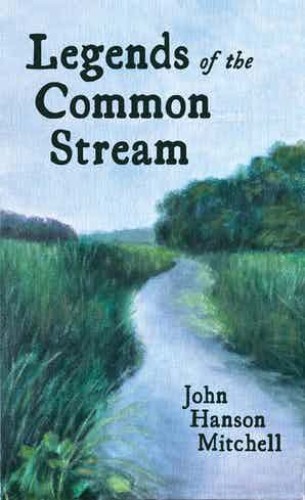by John Hanson Mitchell
Bright Leaf/UMass Press, 2021
Immersing oneself in a place holds expansive potential. John Hanson Mitchell has spent decades exploring Beaver Brook, a stream that winds behind his home in eastern Massachusetts. With a near-daily practice of visiting the brook and interacting with it in such ways as wading through its shallows, navigating it by canoe, skating its meanders, and chatting with its other visitors, he has a rich storehouse of experiences that clearly show through in his new book, Legends of the Common Stream. In chapters organized by month and moon, Mitchell recounts his interactions with and observations of the brook during the course of a year, weaving in details from past explorations as well as legends and myths from across the world.
Mitchell proposes that we think of Beaver Brook as a “common stream,” a colloquial term from medieval Europe describing community waterways that were used for everything from drinking and washing to watering livestock and powering mills. Central to daily life, streams and the creatures that live in and along them have helped to define communities and became fertile subjects for myths and legends throughout human history. Mitchell posits, however, that many present-day
Americans barely notice the streams and rivers in their local landscapes, not even glancing down as they drive their cars across highway bridges that span diverse and storied ecosystems, or knowing the water bodies’ names. Perhaps, Mitchell suggests, by connecting with the complex stories about nature that emerged in earlier human societies around the world, we can reconnect with nature itself at the same time.
Mitchell’s book contains abundant anecdotes detailing his encounters with Beaver Brook’s weather, floods, wildlife, plants, and humans (two neighbors figure prominently) over the course of many years. These first-person observations lead to summaries of the ways these species and phenomena figure in various cultures’ stories or myths. A paragraph about hearing a barred owl, for example, is followed by three pages on the position of owls in stories from ancient Rome, ancient Greece, British and Swedish folktales, Shakespeare, the Mandan and Zuni tribes in North America, and even in 8,000-year-old shelters discovered in the area of Beaver Brook.
Mitchell’s connection to Beaver Brook is clearly deep, and his book is at its best when he is sharing insights that come directly from his daily interactions with the stream. I particularly enjoyed the sections where he reflects on the brook as an entity, with the capacity to connect and define its landscape in a dynamic way. He writes,
“A river, no matter how large or small, is really not any one thing. It is a compilation of waters, and the waters are compilations of lands, of hills, dells, swamps, upland marshes, mountaintops where wood frogs and toads seem to congregate. The essence of a river, or a wide stream like Beaver Brook, is not what you see; it lies somewhere in the surrounding hills, between water and sky, and the narrow summer banks and the wide flooded shores of spring.”
Reflections such as these communicate the wonder that develops through a close and longstanding relationship with a place. The summaries of myths and legends, while interesting, felt more forced and less expert, and almost like a one-sided conversation. Some of these conversations made me uncomfortable, such as when Mitchell repeatedly wonders whether women he meets or has known are snake goddesses or water-naiads. The book would have been stronger if he sought out the perspectives of local Indigenous people instead of presenting American Indigenous traditions through the perspective of his friend, who is not Indigenous. In some of his recollections, I sensed a lost opportunity for Mitchell to deepen his own very place-specific understanding of the cultural significance of the brook in the present day. I appreciate how he frames the brook through alternating close observation with human stories. Both are critical for connecting to place.


